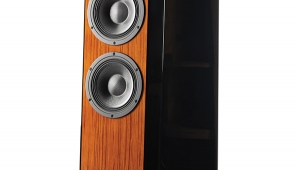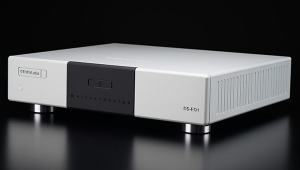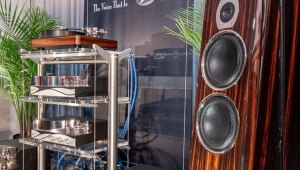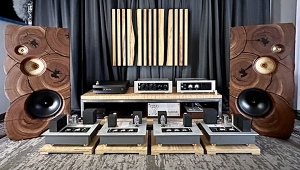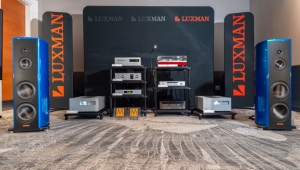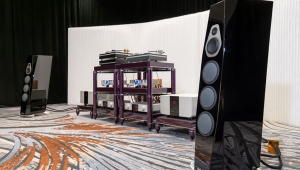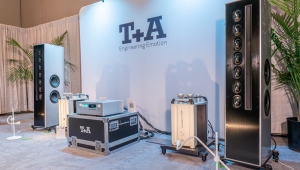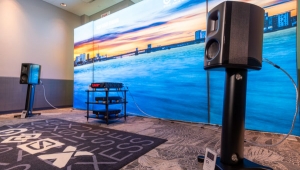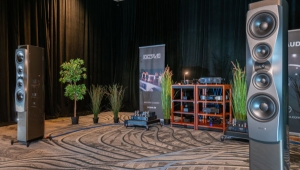| Columns Retired Columns & Blogs |
Listening #33
I'm beginning to understand why some people enjoy writing about crazy tweaks like electron counseling and magic listening trousers: When an idea is that new, it brings with it the chance for some gifted but heretofore unappreciated journalist to rise through the ranks and describe it to an anxious world. By contrast, when a defeated and baggy old establishment writer sets out to describe a CD player or amplifier, the product is surely the millionth such thing to come down the pike, and before long the readers complain: We used to like you, but you don't try very hard to excite us anymore.
Footnote 1: BAC = Big-Ass Choke, custom-made for Wavelength Audio by Magnequest.
Here, then, is news that isn't crazy: Wavelength Audio, the company that made its name as a pioneer in the decidedly retro field of single-ended triode amplifiers, is now among the first to make a perfectionist-quality digital-to-analog converter specifically for use with personal computers. Wavelength has designed two of the things, in fact, and both have tubed output stages.
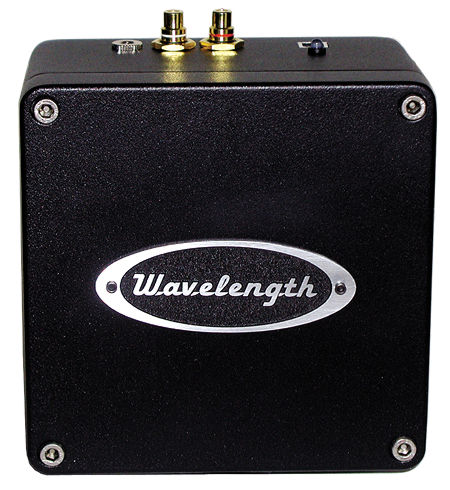
Of course, it's my job to tell you why you might want or even need such a thing—and for once, that's easy: The market for compact discs appears to be taking on water, while the market for downloadable music is sailing briskly, if not always smoothly, ahead. At least, that's what spurred Wavelength Audio's Gordon Rankin to develop and market a computer-driven D/A converter.
"Literally one month before the 2004 CES," Rankin says, "I saw an article on the Internet about how much healthier the music-downloading industry is than the traditional record industry." Rankin, who has a background in mainframe computer design, had recently built a custom universal serial bus (USB) hardware controller for a company that was itself developing a sound-to-PC interface, and he was inspired to build a similar device to deliver the music stored on a person's computer hard drive to his or her high-end audio system. Rankin wasn't the first to make that leap—some companies, especially in the pro audio field, had already brought upgraded soundcards to the market—but he may have been the first to create such a thing for the audio perfectionist: "Most of those products go from the USB connection standard to an S/PDIF environment, and then to an input receiver, but I didn't want to do that. I designed my converter to go straight from the USB connection to the Philips TDA1543 chip."
Rankin's first such product, the prototype of which was completed barely in time for that CES ("On the first day of the show we were still putting pieces of wood on its enclosure," he says), was the Wavelength Cosecant ($3500), a USB D/A converter that was something of a hit from the start. Even so, Rankin admits that, at the time, he didn't see all of the Cosecant's potential. "I was surprised: Even at CES, I had older guys—not just the younger downloader types—coming up to me and suggesting applications for the Cosecant."
Now Wavelength has introduced a newer, lower-cost USB D/A converter: the Brick, a simple but nice-looking black box with an outboard power supply, priced to sail out the door at $1750.
Significantly, Rankin doesn't promote either of his USB converters as a mere accessory for casual listening, but rather as the keystone of a user's primary digital listening system. "A computer is smarter than any transport," Rankin says, "and computers are only getting better. When a transport reads a disc, if there are any errors, they're passed on to the DAC: The transport certainly doesn't reread the track until it gets it right. But a computer has more than enough memory to buffer and reread tracks, and ensure error-free rips. With a computer you can put a whole song into memory—30 megs uncompressed—and cache it out to the USB port, no problem."
Then there's the matter of timing: Any D/A converter and its datastream source must be synchronized with one another, and in a system of digital separates, that's usually accomplished by having the converter lock on to the word-clock signal contained in the datastream from the transport. According to Rankin, the S/PDIF environment is more prone to unwanted variations in the frequency of the incoming word-clock signal, which the converter is always trying to track. But with a USB controller generating its own word-clock signal, the frequency remains steady. "In USB," Rankin says, "the bit clock and the word clock are almost a given: There are only a few frequencies it has to deal with, and if it sees a standard PCM signal coming in, it says, 'What's this? 44.1kHz? Fine—let's go!' It doesn't waver."

There are other reasons Rankin prefers using a computer over a traditional transport: "A computer lets you do more with your music system than a transport does. It can stream radio broadcasts from the Internet. It can let you record, compile, and annotate collections of your favorite music. It can play movies. And a computer's performance can be upgraded without changing the hardware.
"The great thing is, you can buy a dead-quiet laptop computer, add a large FireWire hard drive, and wind up with a killer transport for less than $1250. If you want something more expensive than that, I think you're wasting your money."
Beyond having a USB controller instead of an input receiver chip, the Brick shares a number of similarities with the other D/A converters in the Wavelength stable—key elements of which are Gordon Rankin's fondness for simplicity and purity, and his disdain for oversampling filters. Like Junji Kimura of 47 Laboratory, whose Shigaraki 4715 D/A converter I wrote about in the March 2003 Stereophile, Rankin opts for a zero-oversampling approach, suggesting that digital filters are an unnecessary evil in the first place, and that oversampling, in particular, creates more problems than it cures. "I have a degree in mathematics," he says, "and one thing I firmly believe is that none of these [consumer audio] products, with the possible exception of dCS, has the processing capabilities to actually do the math they need to do. But more important, I don't want to destroy the intent of the original music. My approach is: no math in, no math out."
So much for what's not inside a Wavelength Brick; the components that actually made the cut are a fascinating mix of old and new playback technologies. First there's Gordon Rankin's custom USB controller, which requires no special drivers, and which works with any computer that uses a 1.1-spec or better USB audio connection—meaning that Windows 98se and above, Macintosh OS9 and above, and Linux 2.4.22 or above will all make friendly neighborhoods for the Brick. The controller gathers the input datastream and buffers it, and sends it out in I2S format to the above-mentioned 16-bit Philips converter chip. Current-to-voltage conversion is done passively, using 1%-tolerance film resistors, and the output voltages go directly to a 12AU7 dual triode tube.
That tube is configured as a reactor-follower, which Rankin says is similar to a cathode follower, except that it uses a BAC (footnote 1) instead of a resistor as a current source: The follower buffers the output (in the keeps impedance low sense of the word). The power supply, which is driven by a high-quality wall wart, uses a pair of Linear Technology voltage regulators to feed various portions of the circuit, and contains no fewer than 10 ultra-high-quality Black Gate capacitors.
I can say with hand on heart: Installing the Brick is a breeze. Simply plug in the wall wart, use a USB cable to connect the Brick to your PC or Mac, and, assuming your computer is already booted up, run the appropriate routine so the Brick can be recognized and addressed for what it is. (An EEPROM within the Brick's USB controller contains all the information your computer requires: No additional software is necessary.) An interconnect pair of the usual sort takes the Brick's analog output to the preamp or integrated amp of your choice, and the only other thing you should be aware of is that the Brick's output voltage appears to be about 10–15% lower than average. By the way, the Brick does not invert absolute signal polarity.
For my first trial, Wavelength Audio loaned me a fully tricked out Apple Mac Mini G4 system with 1GB of RAM and v.10.3.8 of Mac's OS X. I used the cable supplied with the Brick for the USB connection, and ran a long pair of Nordost Valkyrja interconnects from its analog outputs to the line-level inputs of my Fi preamp. The Mac Mini was Gordon Rankin's spare computer, which he'd already equipped with 32GB of music burned from his own collection, and because his tastes and mine have a number of points in common—XTC and the Clash were well represented—I was up and running, listening to music I knew and loved, in less than half an hour.
But before you assume the worst from our friends on the other side of Styx (the river, not the poodle-rockers), let me say from the get-go: Within one second of connecting the powered-up Brick to the USB port of my grimy, despised, five-year-old Gateway, itself running the lustily and rightly hated Windows XP, the Found New Hardware dialog box appeared on the screen. I went to My Computer > Control Panel > Audio Devices, and there it was: "WA Brick USBDAC." It worked without a hitch.
One other note: The Brick is designed so that its USB controller and D/A chip are powered up all the time, but when the computer is turned off or in "sleep" mode, the filament and rail voltages are removed from the 12AU7 tube and a relay mutes the analog output, so no pops or thuds are heard through the music system that it's connected to.
So then: Given a Wavelength Brick and a hard drive full of music, do you really need anything else? I suppose that all depends—the greatest variable being, How did all that music get on your hard drive in the first place?
The best and most obvious answer is I put it there myself. So it goes with Gordon Rankin—who, as I mentioned above, had already ripped a number of selections from his own music library onto the hard drive of the Mac Mini on my desk. I wondered, quite naturally: Do those songs sound as good coming from the computer and the Brick as they do when I play my own CD copies?
The differences I heard between the two formats on XTC's "Books Are Burning," from Nonsuch (CD, Geffen GEFD-24474), were the sort of differences I might expect to hear from two different CD players, or perhaps two different D/A converters. Both were acceptably good: I enjoyed the song as well through the Mac Mini and Brick driving my preamp as I did with the actual CD spinning in the Linn Unidisk SC, which has come back to roost for a short time. While auditioning the computer system, I listened carefully for cymbal decays during loud passages, and subtle spatial cues. (I'm by no means an imaging freak, but such things can reveal problems with low-level detail, phase distortion, and good ol'-fashioned noise.) I heard nothing that troubled me, and a lot to like—such as the nicely fleshed-out sound of Colin Moulding's electric bass, which remained nimble and on pitch. When listening to the regular CD I did get the impression that the snare drum and tambourine were struck with greater force, but the difference wasn't great enough to tip my overall satisfaction one way or the other.
Interestingly, those roles were entirely reversed with the next comparison I made: the CD of the Chieftains' Long Black Veil (Columbia 62702-2). Again, both digital formats were enjoyable, although in a blind test I might have said my own CD was the more compressed of the two: The computer-delivered version was rhythmically sharper, and voices—such as Sinead O'Connor's, on her nice performance of "He Moved Through the Fair"—had a little more presence and texture.
I tried something unfair: Gordon had the Clash's Super Black Market Clash (Columbia 63895) on his Mac, so I played "Justice Tonight/Kick it Over" and enjoyed it greatly. Then I dug out my 10" vinyl copy (Black Market Clash, Epic 4E 36846) and compared the two: As far as sheer involvement was concerned, the computer wasn't embarrassed in the least, although all the percussion (and I lump Paul Simonon's electric bass in with that, since that's more or less how he approaches the instrument) had greater impact off the vinyl. After that, I couldn't resist the temptation to be even more unfair, and to spin my original 12", 45rpm version of same (CBS 12-8087), and the bass was soooo much deeper and more forceful that I had to laugh out loud. (I didn't know my Quads could do that!)
Then there's the little matter of downloadable music.
Before I go any further, I assure you that this isn't just another attempt to use an unfair comparison—a really unfair one this time—to get a cheap laugh: I realize that the playing back of compressed music files is not what the Brick's designer sees as a primary use for his product. Still, it's incumbent on any vintner to acknowledge that at least some of his product will wind up being mixed with Sprite and spilled to the sounds of "La Macarena."
So I did it. I opened an iTunes account of my own and downloaded $15 worth of music onto the Mac. (Hope you like bluegrass, Gordon.) The results, though less than stunning, were at least minimally satisfying. I bought "Blackberry Blossom," by the Tony Rice Unit, and while it sounded airless and undynamic, and while a lot of nice details went AWOL—such as the cool syncopated bass lines Tony plays on his guitar behind David Grisman's mandolin solo—I was nonetheless able to get something out of it. I tapped my foot, and at one point even caught myself playing air Dobro along with Jerry Douglas.
Classical music suffered more. I downloaded the Emerson Quartet's performance of Beethoven's String Quartet 11, but the sound was so lacking in drama, nuance, and texture that the recording was suitable for nothing more challenging than background music. Then again, maybe that's the point: While the variety of popular music available from iTunes is commendable—obscure gems like Shiny Beast (Captain Beefheart), Vintage Violence (John Cale), and The Spirit Cage (Martin Newell and the Cleaners from Venus) are all available at the click of a mouse—the selection of orchestral and chamber music betrays a shallow, Sunday-brunch approach to the classics.
But let's be real: The "Blackberry Blossom" file was only about 2.6MB, and a single movement of the Beethoven was scarcely more than that; storing an uncompressed version of the same piece would require more than 10 times the storage space.
I don't have any use for background music—but I don't mind having cheap, easy access to individual songs, so I can predict whether I'll want to own a certain album or not. I can put up with limited fidelity if it means being able to buy great songs like "The Girl of My Dreams" (Bram Tchaikovsky), "A Million Miles Away" (the Plimsouls), or "Too Many People" (Paul and Linda McCartney) without also having to buy the junk they came packaged with. And, as an amateur musician, I'm often asked to learn individual songs by artists to whom I'm otherwise indifferent. That's a privilege I'd rather not pay more than 99 cents for. Personally.
And I'm intrigued by the promise of audiophile-quality downloads, such as the ones hinted at by www.MusicGiants.com. (See Wes Phillips' recent piece about that forthcoming service.) By that time, maybe something faster than 56k dial-up service will be available in Cherry Valley.
So for me, the Brick remains a wait-and-see sort of thing, but one with exceptional promise. I was genuinely excited when I got it up and running with Gordon's Mac—a rare instance of a new audio product being really fun—and I can see myself nudging in that direction, even as I spend more time and money on step-up transformers and monophonic records for the system in the next room.
Footnote 1: BAC = Big-Ass Choke, custom-made for Wavelength Audio by Magnequest.
- Log in or register to post comments
















